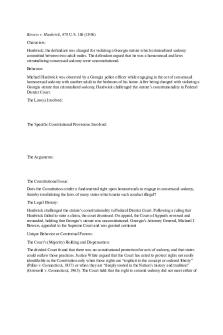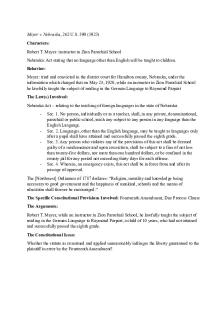Honig v. Doe Case Brief and Notes PDF

| Title | Honig v. Doe Case Brief and Notes |
|---|---|
| Course | Special Education |
| Institution | Touro College |
| Pages | 2 |
| File Size | 77.3 KB |
| File Type | |
| Total Downloads | 16 |
| Total Views | 201 |
Summary
Case Brief Notes...
Description
Special Education Law Honig v. Doe Parties: - Respondents ! Doe and Smith – emotionally disturbed students - Petitioner ! Honig- California Superintendent of Public Instruction Procedural History: - Doe and Smith file suit against the school district in the US District Court - DC entered summary judgment for Respondents and issues a permanent injunction ! Petitioner appealed - Court of Appeals, Ninth Circuit affirmed ! Petition for writ of cert Issue: - Whether state or local school authorities may unilaterally exclude disabled children from the classroom for dangerous or disruptive conduct growing out of their disabilities - Whether a district court may, in the exercise of its power, order a State to provide educational services directly to a disabled child when the local agency fails to do so Holding: - The case is moot against Doe who is outside the eligibility age range of the Act, but not moot for Smith - Under the Stay-Put provision of the EHA, disabled children cannot be unilaterally excluded from the classroom from dangerous or disruptive conducting stemming from their disabilities during the pendency of the review proceeding - The trial court did not abuse its discretion in enjoining local school officials from indefinitely suspending emotionally handicapped students pending completion of expulsion proceedings. Basis for Dispute: - Respondents were suspended indefinitely for violent and disruptive conduct related to their disabilities, pending the completion of expulsion proceedings - Doe: o IEP goals was to improve his ability to relate to his peers and to cope with frustrating situations without resorting to aggressive acts o recommended by Doe’s principal that he be expelled - Smith: o IEP recommended placement in a Learning Disability Group, stressing the need for close supervision and a highly structured environment o Principal recommended expulsion
Arguments: - Doe and Smith: the suspension and proposed expulsion violated the Education of the Handicapped Act - Honig: The Court of Appeals’ construction of the stay-put provision conflicted with that of several other Court of Appeals which had recognized a dangerousness exception, and that the direct services ruling placed an intolerable burden on the State o Congress could not have intended the provision to be read literally Reasoning: - The stay put provision of the EHA mandates that disabled children shall remain in his or her then current educational placement pending completion of any review proceedings, unless the parents and state or local educational agencies otherwise agree - The misconduct of an emotionally disturbed or otherwise disabled child who has not yet reached adolescence typically will not pose such a serious threat to the well being of other students that school officials can only ensure classroom safety by excluding the child...
Similar Free PDFs

Lubitz v Wells Case Brief Notes
- 2 Pages

Wesson v. Walmart - case brief
- 2 Pages

Morse v Frederick Case Brief
- 2 Pages

Graham v Connor - Case Brief
- 1 Pages

Barrenblat v US Case Brief
- 2 Pages

Spivey v Battaglia Case Brief
- 2 Pages

Florida v Jardines - Case Brief
- 2 Pages

Lemon v. Kurtzman - Case Brief
- 1 Pages

Obrien v cunard case brief
- 1 Pages
Popular Institutions
- Tinajero National High School - Annex
- Politeknik Caltex Riau
- Yokohama City University
- SGT University
- University of Al-Qadisiyah
- Divine Word College of Vigan
- Techniek College Rotterdam
- Universidade de Santiago
- Universiti Teknologi MARA Cawangan Johor Kampus Pasir Gudang
- Poltekkes Kemenkes Yogyakarta
- Baguio City National High School
- Colegio san marcos
- preparatoria uno
- Centro de Bachillerato Tecnológico Industrial y de Servicios No. 107
- Dalian Maritime University
- Quang Trung Secondary School
- Colegio Tecnológico en Informática
- Corporación Regional de Educación Superior
- Grupo CEDVA
- Dar Al Uloom University
- Centro de Estudios Preuniversitarios de la Universidad Nacional de Ingeniería
- 上智大学
- Aakash International School, Nuna Majara
- San Felipe Neri Catholic School
- Kang Chiao International School - New Taipei City
- Misamis Occidental National High School
- Institución Educativa Escuela Normal Juan Ladrilleros
- Kolehiyo ng Pantukan
- Batanes State College
- Instituto Continental
- Sekolah Menengah Kejuruan Kesehatan Kaltara (Tarakan)
- Colegio de La Inmaculada Concepcion - Cebu






